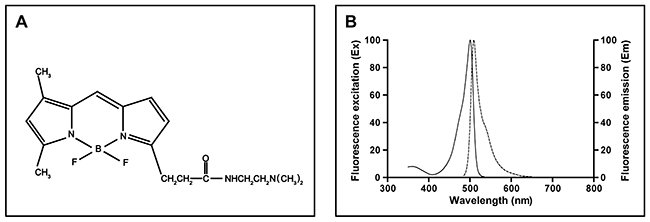Lyso-Tracker Green

目录号 : GC20101
Lyso-Tracker Green是一种溶酶体(lysosome)绿色荧光探针,能通透细胞膜,可以用于活细胞溶酶体特异性荧光染色。

Sample solution is provided at 25 µL, 10mM.
Lyso-Tracker Green是一种溶酶体(lysosome)绿色荧光探针,能通透细胞膜,可以用于活细胞溶酶体特异性荧光染色。
Lyso-Tracker Green为采用Molecular Probes公司的DND-26进行了荧光标记的带有弱碱性的荧光探针,其中仅弱碱可部分提供质子,以维持pH在中性,可以选择性地滞留在偏酸性的溶酶体中,从而实现对于溶酶体的特异性荧光标记。中性红(Neutral Red)和吖啶橙(Acridine Orange)也都可以对溶酶体进行荧光染色,但中性红和吖啶橙的染色缺乏特异性。Lyso-Tracker Green适用于活细胞染色,但不适合用于固定后细胞的染色。
Lyso-Tracker Green的分子式为C18H26BClF2N4O,分子量为398.7,其最大激发光波长为504nm,最大发射光波长为511nm。Lyso-Tracker Green的化学结构式和激发、发射光谱图参考图1。

图1. Lyso-Tracker Green的化学结构式(A)和激发、发射光谱图(B)。
Lyso-Tracker Green是嗜酸性荧光探针,用于活细胞内酸性细胞器的标记和示踪。这些探针具有几个重要特征,包括高度选择靶向酸性细胞器和在纳摩尔浓度有效标记活细胞。Lyso-Tracker Green必须在极低浓度(通常约50nM)下才能获得优异的选择性。这些探针的滞留(retention)机制虽然没有被研究清楚,但很可能与酸性细胞器的质子化和滞留性有关,Lyso-Tracker Green探针的内吞作用动力学研究显示染料进入活细胞的摄入时间仅几秒即可。然而,这些溶酶体探针会导致溶酶体被碱化,长期孵育会诱使溶酶体pH值的增加。因此,建议成像前用探针孵育细胞的时间不能太久。Lyso-Tracker Green探针具体使用浓度和孵育时间需要根据自身实验条件和具体细胞种类来进行摸索以达到满意的染色效果。Lyso-Tracker Green染色活细胞溶酶体的效果请参考图2。

图2. Lyso-Tracker Green染色NRK-52E细胞(大鼠肾小管上皮细胞)的效果图。Hoechst 33342染色的NRK-52E细胞其细胞核呈现蓝色荧光;Lyso-Tracker Green染色的NRK-52E细胞其溶酶体呈现绿色荧光。
按照1:20,000的比例稀释,可以配制1000ml Lyso-Tracker Green工作液。
本方案仅提供一个指导,请根据您的具体需要进行修改。
1、制备Lyso-Tracker Green染色液
(1)取出冻存的染色液,恢复至室温后,通过瞬时离心将染液集中在管底。
(2)工作液制备:用合适的缓冲液(如:无血清培养基或PBS)稀释储存液(1mM),配制浓度为50-75nM的工作液。
注意:
① 请根据实际情况调整工作液浓度,现用现配;
② 为了减少背景过高或过载产生的假阳性现象,染料的浓度应尽可能低;
③ 若细胞在染色后在不含染料的缓冲液中孵育,会观察到荧光信号的衰减和细胞的空泡化现象。
2、细胞悬浮染色
(1)悬浮细胞:悬浮细胞经4°C、1000g离心3-5分钟,弃去上清液,使用PBS清洗两次,每次5分钟。
(2)贴壁细胞:使用PBS清洗两次,加入胰酶消化细胞,消化完成后经1000g离心3-5min。
(3)使用0.5-1mL工作液重悬约106个细胞,37℃避光孵育30分钟至2小时。不同细胞最佳孵育时间不同,请根据具体实验需求自行摸索。
(4)孵育结束后,经1000g离心5分钟,去除上清液,加入PBS清洗2-3次,每次5分钟。
(5)使用预温的细胞培养基重悬孵育细胞。
3、细胞贴壁染色
(1)在无菌盖玻片上培养贴壁细胞。
(2)从培养基中移走盖玻片,吸出过量的培养基,将盖玻片放在潮湿的环境中。
(3)从盖玻片的一角加入100μL的染料工作液,轻轻晃动使染料均匀覆盖所有细胞。
(4)37℃避光孵育30分钟至2小时。不同细胞最佳孵育时间不同,请根据具体实验需求自行摸索。
(5)孵育结束后吸弃染料工作液,加入PBS清洗2-3次,使用预温的培养基孵育细胞。
4、荧光检测:Lyso-Tracker Green的最大吸收波光/发射光为504/511nm。
注意事项:
① 对Lyso-Tracker探针的内化进行动力学研究发现,活细胞摄取此探针的速率在几秒之内即可完成,但该探针展示出溶酶体“碱化效应”,长时间孵育会导致溶酶体pH上升,因此,当此探针于37℃孵育细胞1-5min才是有用的pH指示剂;
② 若染色不够充分,建议增加染料浓度或延长染色时间,使得染料能聚集在溶酶体上;
③ 荧光染料均存在淬灭问题,请尽量注意避光,以减缓荧光淬灭;
为了您的安全和健康,请穿实验服并戴一次性手套操作。
| Cas No. | SDF | ||
| 分子式 | C18H26BClF2N4O | 分子量 | 398.7 |
| 溶解度 | 储存条件 | Store at -20℃,protect form light | |
| General tips | 请根据产品在不同溶剂中的溶解度选择合适的溶剂配制储备液;一旦配成溶液,请分装保存,避免反复冻融造成的产品失效。 储备液的保存方式和期限:-80°C 储存时,请在 6 个月内使用,-20°C 储存时,请在 1 个月内使用。 为了提高溶解度,请将管子加热至37℃,然后在超声波浴中震荡一段时间。 |
||
| Shipping Condition | 评估样品解决方案:配备蓝冰进行发货。所有其他可用尺寸:配备RT,或根据请求配备蓝冰。 | ||
| 制备储备液 | |||
 |
1 mg | 5 mg | 10 mg |
| 1 mM | 2.5082 mL | 12.5408 mL | 25.0815 mL |
| 5 mM | 501.6 μL | 2.5082 mL | 5.0163 mL |
| 10 mM | 250.8 μL | 1.2541 mL | 2.5082 mL |
| 第一步:请输入基本实验信息(考虑到实验过程中的损耗,建议多配一只动物的药量) | ||||||||||
| 给药剂量 | mg/kg |  |
动物平均体重 | g |  |
每只动物给药体积 | ul |  |
动物数量 | 只 |
| 第二步:请输入动物体内配方组成(配方适用于不溶于水的药物;不同批次药物配方比例不同,请联系GLPBIO为您提供正确的澄清溶液配方) | ||||||||||
| % DMSO % % Tween 80 % saline | ||||||||||
| 计算重置 | ||||||||||
计算结果:
工作液浓度: mg/ml;
DMSO母液配制方法: mg 药物溶于 μL DMSO溶液(母液浓度 mg/mL,
体内配方配制方法:取 μL DMSO母液,加入 μL PEG300,混匀澄清后加入μL Tween 80,混匀澄清后加入 μL saline,混匀澄清。
1. 首先保证母液是澄清的;
2.
一定要按照顺序依次将溶剂加入,进行下一步操作之前必须保证上一步操作得到的是澄清的溶液,可采用涡旋、超声或水浴加热等物理方法助溶。
3. 以上所有助溶剂都可在 GlpBio 网站选购。
Quality Control & SDS
- View current batch:




